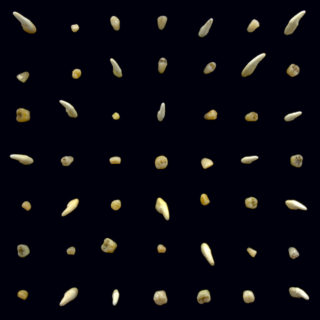Clipping
Visions of Bodies Being Burned
(Sub Pop)
9/10

(Sub Pop)
9/10
More so than any other genre, horror has a shared history of sequels upon sequels, wherein whole franchises grow from singular baddies. Anyone can be scary for the duration of one film, but it’s the fiends that remain terrifying after multiple sequels that live longest in the imagination. Often, it is the sequels that are the key to the legacies of the screens’ greatest monsters.
A prime example is Nightmare on Elm Street’s very own melted Paolo Nutini antagonist, Freddy Krueger. Amidst the fog and analogue synth soundtrack of the original, glimpses of him are stark and terrifying, but it’s as he’s fleshed out in the second and third installments that Krueger really comes into his own.
In Freddy’s Revenge and Dream Warriors, the besweatered dream assassin flaunts a razor-sharp wit to match his talons, cackling away as he indulges in increasingly nonsensical murders. All mystique vanishes, but it’s replaced with something far better; fleeting murderers are scary, but there’s something far scarier about a serial killer with a lavish grin on his face. In the especially schlocky third film, Krueger murders a nurse by reaching out of a TV; as his cyborg arms smash her into the glass, Freddy duly cackles “Welcome to prime time, bitch!”
Indeed, the list of horror sequels that develop their respective mythos is vast and insurmountable. For me, the Texas Chainsaw Massacre 2 is another one that sees the schlock ramped up, but after one viewing the protagonist seems even scarier than in the ultra-tense original. Leatherface gets even more terrifying as his gormless fleshy chops have more chance to hog the camera.
Wes Craven’s Scream 2 fills this mould even more willingly. In fact, it’s cited by LA hip-hop experimentalists Clipping as a vital part of the ethos that fuels their own follow-up horror. The second Scream film gets sickeningly meta, as Randy, the movie’s laborious plot-explaining film bro, explains the rules of the sequel. “There are certain rules that one must abide by in order to create a successful sequel,” he explains. “Number one: the body count is always bigger. Number two: the death scenes are always much more elaborate – more blood, more gore. Carnage candy. And number three: never, ever, under any circumstances, assume the killer is dead.”
Whilst startlingly on-the-nose, this hypothesis is nonetheless often applicable. As Clipping ready their very own vital horror sequel, it’s clear from the outset that there will be far more of everything than before. Starring a Grammy- and Tony award-winning lead alongside an all-star ensemble of features and cameos, Visions of Bodies Being Burned fits perfectly into this lineage of essential part twos.

The most important thing for a classic sequel is that it follows a classic original, and 2019’s There Existed an Addiction to Blood is just that. Daveed Diggs, perhaps most notable to a wider audience for his lightning fast-rapping in the original production of Hamilton, leads his indomitable trio through a series of vignettes that evoke classic horror films effortlessly. Diggs finds his calling as a storyteller with his eternally novel second-person bars mangling the industrial beats of Jonathon Snipes and William Hutson. There Existed an Addiction to Blood saw Clipping draw a black line in Sharpie between noise music and horror films, where before there were only pencil marks.
On that albums, Clipping laid the groundwork for a distinctly avant-garde take on hip-hop that has the rich history of horror cinema running through it: their videos paid homage to films like Halloween and Diggs’ breathless flow vividly described scenes akin to horror flicks. It was wholly fresh, and the misty pictures became clearer with every listen. But this isn’t the first time that horror and hip-hop have shared space on wax.
The two media have always had more than just a working relationship. In the 1980s and ’90s, select hardcore MCs melded their murky rhymes with grindhouse subject matter, horror film samples and occasional Wilhelm screams to create the genre horrorcore. Whilst Kool Keith claims to have created the genre, with his Dr Dooom and Dr Octagon monikers, as well as with frequent spooky forays with Ultramagnetic MCs, the ‘horrorcore’ term envelops artists from Scarface right up to the Insane Clown Posse. Notably, whilst the RZA was reshaping hip-hop to the tune of Shaw Brothers Kung Fu flicks in the Wu-Tang Clan, his other outfit, Gravediggaz, released the epochal Six Feet Deep, which does the very same thing with slasher flicks.
Visions of Bodies Being Burned is the fourth Sub Pop album by Clipping, and in true horror sequel fashion it arrives less than 12 months after There Existed an Addiction to Blood. It places the group clearly in a lineage of horrorcore groups, albeit with their own entirely novel sonic tropes and attitudes. The industrial hip-hop group fully embraces this aesthetic, creating a postmodern horrorcore aesthetic and finishing what they started last year. More of a planned diptych than a rushed sequel, admittedly, Visions of Bodies Being Burned follows up what was the group’s best album to date with something even better.
The calling card of most horror series – the Nightmare on Elm Street films particularly – is that they’re driven by showy and dramatic set-pieces rather than a gripping overarching plot. The same can be said of Visions of Bodies: ever cinematic, the instantaneous feelings evoked by Diggs’ breathy rapping take precedence above a consistent concept.
Lead single ‘Say the Name’ is the foremost of these; a magnificent set-piece employed to devastating effect. Following a tense intro track that sounds like someone escaping a killer, ‘Say the Name’ is the most instantly gratifying of any Clipping song. It revolves around a slinking synth bassline and a repeated low frequency manipulated vocal sample, working as a freaked-out theme tune to the proceedings. The sample takes centre stage, an homage of its own – Diggs’ own rerecording of horrorcore pioneers Geto Boys – and rumbles through the night as the track makes its way to its heady climax.
Daveed Diggs is known worldwide for his fast delivery. His lines in Hamilton are faster than Eminem’s indecipherable ‘Rap God’ verse (‘Body for the Pile’, on which the LA MC sounds more tommy gun than human, is the best example of this on the album), but his ultra-laidback flow on ‘Say the Name’ adds malevolence to a number that already screams evil.
He brings to life the Candyman here, the first character to rear their head on the album, starting each verse with “The hook gon’ be”, and increasing in venom every time. Conceived in Hellraiser creator Clive Barker’s Books of Blood vol. 5, The Candyman has all the tropes of the playground-conceived urban legend: he has the ability to appear when his name is repeated five times into the mirror, and he has hooks for hands. Hooks for hands!
The homages to the group’s collection of scary movies continues with ‘96 Neve Campbell’, featuring Cam & China, the record’s first supporting actors. Here, the LA twins steal the spotlight from Diggs. A vocal motif of “this bitch boss” refers unflinchingly to Neve Campbell, of the Scream films, delivered with ice-cold irreverence. Clipping’s production duo make use of door-knocking samples on a track that recalls the terror and malevolence of a classic slasher.
The most notable feature, though, comes from New Jersey cybercore outfit Ho99o9, on ‘Looking Like Meat’. The track itself recalls the industrial music that Hutson and Snipes’ production is best known for: real scorched Earth noise echoing Throbbing Gristle, whilst the sonic field is entirely populated by invasive malfunctioning synthesisers. “No-one cares about your bars,” utters Diggs ‘neath the miasma, “their screams are what they wanna hear.”
The trio’s most successful attempt at creating a hybrid of horrorcore and industrial terror, ‘Looking Like Meat’ is a real highlight, whilst ‘Eaten Alive’, featuring Tortoise’s Jeff Parker, combines this sound with scratchy scattergun jazz freedom. Throughout, Clipping stun and shock with their most complete work to date, and Visions of Bodies Being Burned proves the group to be as dynamic as they are devastating. Many genres are taken in, but the end product always has Clipping’s fingerprints all over it. Indeed, with this postmodern horrorcore record, the LA trio have achieved something that hasn’t been done since Nightmare On Elm Street – a sequel that is not just better than the original, but a standalone classic in its own right.